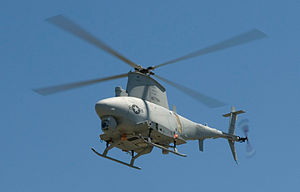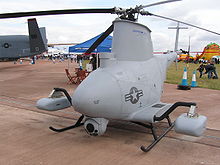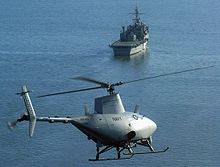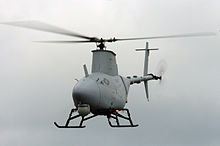- Northrop Grumman MQ-8 Fire Scout
-
MQ-8 Fire Scout A US Navy MQ-8B with the BRITE Star II electro-optical/infrared payload at Webster Field, NAS Patuxent River, Maryland Role UAV helicopter Manufacturer Northrop Grumman First flight 2002 Primary users United States Navy
United States ArmyDeveloped from Schweizer 330 and 333 Developed into Sikorsky S-434 The Northrop Grumman MQ-8 Fire Scout is an unmanned autonomous helicopter developed by Northrop Grumman for use by the United States Armed Forces.[1] The Fire Scout is designed to provide reconnaissance, situational awareness, and precision targeting support for ground, air and sea forces. The initial RQ-8A version was based on the Schweizer 330, while the enhanced MQ-8B was derived from the Schweizer 333.
Contents
Design and development
RQ-8A
As the US Navy was withdrawing its RQ-2 Pioneers from service, it began to seek a second generation UAV. The Navy requirement specified a vertical takeoff & landing (VTOL) aircraft, with a payload capacity of 90 kilograms (200 pounds), a range of 200 kilometers (125 miles), an endurance on station of three hours at an altitude of 6 kilometers (20,000 ft), and the ability to land on a ship in a 46 km/h (29 mph) breeze. The UAV was to fly 190 hours between maintenance.
There were three finalists in the competition, which was designated "VTOL-UAV" or "VTUAV". Bell, Sikorsky, and a collaboration of Teledyne Ryan and Schweizer Aircraft submitted designs. The Ryan-Schweizer UAV was selected as the winner in the spring of 2000. The RQ-8A Fire Scout, as it was named, was a derivative of the Schweizer three-passenger, turbine powered 330SP helicopter, with a new fuselage, new fuel system, and UAV electronics and sensors.
The initial prototype of the Fire Scout was piloted in initial tests, flying autonomously for the first time in January 2000. The Rolls-Royce 250-C20 turbine engine ran on JP-5 and JP-8 jet fuel, which is nonvolatile and safe for shipboard storage.
The Fire Scout was to be fitted with a sensor ball turret that carries electro-optic and infrared cameras, and a laser range finder. It was to be controlled over a data link derived from the Northrop Grumman RQ-4 Global Hawk UAV, operating over a line of sight to a distance of 280 kilometers (172 miles). The control system was to be fitted onto a ship, or could be carried on a Humvee light vehicle for U.S. Marine service.
MQ-8B
Although progress on the project had been regarded as satisfactory, the Navy decided the Fire Scout didn't meet their needs after all, and cut funding for production in December 2001. However, the development program continued, and Northrop Grumman pitched a range of improved configurations to anyone who was interested. As it turned out, the U.S. Army was very interested, awarding a contract for seven improved RQ-8B evaluation machines in late 2003. In 2006, it was redesignated MQ-8B.
The MQ-8B features four-blade main rotor, in contrast to the larger-diameter three-blade rotor of the RQ-8A, to reduce noise and improve lift capacity and performance. The four-blade rotor had already been evaluated on Fire Scout prototypes. They boost gross takeoff weight by 500 pounds to 3,150 pounds (by 225 kg to 1,430 kg), with payloads of up to 700 pounds (320 kg) for short-range missions.
The MQ-8B is fitted with stub wings which serve both an aerodynamic purpose as well as an armament carriage location. Weapons to be carried include Hellfire missiles, Viper Strike laser-guided glide weapons, and in particular pods carrying the "Advanced Precision Kill Weapon System (APKWS)", a laser-guided 70 millimeter (2.75 inch) folding-fin rocket, which the Army sees as ideal for the modern battlefield. The Army is also interested in using the Fire Scout to carry up to 200 pounds (90 kilograms) of emergency supplies to troops in the field.
The MQ-8B is being modified to permit rapid swap out of payload configurations. The current sensor configuration of a day/night turret with a laser target designator will remain an option. Alternate sensor payloads in consideration include a TSAR with Moving Target Indicator (MTI) capability, a multispectral sensor, a SIGINT module, the Target Acquisition Minefield Detection System (ASTAMIDS), and the Tactical Common Data Link (TCDL). The Army wants the Fire Scout to operate as an element of an integrated ground sensor network as well.
Production of the flight test airframes was initiated in April 2006 at the Northrop Grumman Unmanned Systems production plant in Moss Point, Mississippi. The Navy approved low-rate initial production.[2] First flight of the MQ-8B took place on December 18, 2006 at NAS Patuxent River.
The Army interest revived Navy interest in the program, with the Navy ordering eight Sea Scout MQ-8B derivatives for evaluation. In January 2010, the Army terminated its involvement with the Fire Scout contending that the RQ-7 Shadow UAV could meet the Army's needs.[3]
The MQ-8B complements the manned aviation detachments onboard Air Capable ships and is deployed along with either an SH-60B HSL/HSM detachment or a SH-60S HSC detachment. With the planned addition of RADAR, AIS, and weapons, the MQ-8B will provide many of the capabilities currently provided by the SH-60B. It will give the ship and embarked air detachment greater flexibility in meeting mission demands, and will free manned aircraft for those missions.[citation needed]
Northrop Grumman has started work outfitting the MQ-8B with a weapons system. The Advanced Precision Kill Weapon System laser-guided 70 mm rocket. The corporation will develop and deliver the equipment needed to control the weapons system under a $17 million contract awarded to the company 23 September 2011 by Naval Air Systems Command. Final delivery of an operational system is expected by March 2013.[4]
Operational history
In January 2006, an RQ-8A Fire Scout landed aboard the U.S. Navy warship USS Nashville while it was steaming off the coast of Maryland near the Patuxent River. This marked the first time an unmanned helicopter has landed autonomously aboard a moving U.S. Navy ship without a pilot controlling the aircraft.[5][6][7] The USS Nashville, which is an amphibious transport ship, was maneuvering as fast as 17 mph (27 km/h) in the tests.
The flight test program is underway. Production aircraft will eventually be deployed on the Navy's Littoral Combat Ships. In February 2008, the U.S. Navy announced that they would integrate the MQ-8B Fire Scout VTUAV onto another air-capable ship before it reaches the Littoral Combat Ship (LCS).[citation needed]
 An MQ-8B is maintained at Marine Corps Air Station Cherry Point
An MQ-8B is maintained at Marine Corps Air Station Cherry Point
The Fire Scout is a key enabler for LCS and significantly contributes to its designated warfare mission areas of anti-submarine warfare, surface warfare and mine warfare. The modular nature of the ship to accomplish the designated mission is complemented by the Fire Scout and its modular mission payload capability. However, due to changes in the LCS development schedule, the Navy conducted the Fire Scout Operational Evaluation (OpEval) aboard USS McInerney (FFG-8).[8] This will provide the fleet with unmanned aerial system support as soon as possible. The Fire Scout first embarked aboard the guided-missile frigate USS McInerney, an Oliver Hazard Perry-class frigate, while in port for operational fit checks and ship integration testing on December 10, 2008. The Fire Scout was slated to deploy aboard USS McInerney during its next counter-narcotics trafficking deployment later in 2009.[9]
According to the current schedule, the Navy conducted Technical Evaluation on the Fire Scout on the FFG-8 in the fall 2008 and Operational Evaluation in the summer 2009. The Fire Scout was to reach Initial Operating Capability soon after the evaluation. The Navy will continue to support LCS Initial Operational Test and Evaluation (IOT&E) efforts in fiscal year 2011.[10]
Flight tests took place 4–8 May 2009 off the coast of Mayport, Fla. The U.S. Navy Fire Scout completed test flights in areas of shipboard deck motion and wind envelope expansion and landings including the use of the grid and harpoon system. During the five days of testing, the ship/aircraft team compiled 19 flight hours during 12 flights, which included 54 landings, 37 of which were into the NATO standard grid.[9]
In September 2009, the Navy announced the first deployment of the MQ-8B aboard McInerney.[11]
On 3 April 2010, an MQ-8 from McInerney detected a "go-fast" open speedboat and a support vessel engaged in smuggling cocaine in the Eastern Pacific, allowing the ship to confiscate 60 kg of cocaine and detain a number of suspects.[12] On 2 August 2010 an MQ-8 became unresponsive to commands during testing and entered restricted airspace around Washington, D.C.[13][14]
In May 2011, three MQ-8s were deployed to northern Afghanistan for ISR, a mission which has been extended another year.[15]
On 21 June 2011, a MQ-8 operating from USS Halyburton (FFG-40) as part of Operation Unified Protector was shot down over Libya during a surveillance and reconnaissance mission.[16][17] Aboard the Halyburton, the Fire Scouts were flown and maintained by the ship's SH-60 detachment, HSL-42.[18]
Variants
- RQ-8A
- RQ-8B
- MQ-8B
Operators
- United States Navy 168 planned[19]
Specifications (MQ-8B)
Data from Northrop Grumman,[20] Nav Air[19]
General characteristics
- Crew: 0
- Payload: 600 lb (272 kg)
- Length: 23.95 ft (7.3 m)
- Rotor diameter: 27.5 ft (8.4 m)
- Height: 9.71 ft (2.9 m)
- Empty weight: 2,073 lb (940.3 kg)
- Max takeoff weight: 3,150 lb (1,430 kg)
- Powerplant: 1 × Rolls-Royce 250, 313 kw ()
Performance
- Maximum speed: 115 knots (213 km/h)+
- Cruise speed: 110 knots (200 km/h)
- Combat radius: 110 nmi (203.7 km) plus 5+ hours on station
- Endurance: 8 hours
- Service ceiling: 20,000 ft (6,100 m)
See also
- Related development
- Schweizer 330 and 333
- Schweizer S-434
- Aircraft of comparable role, configuration and era
- Related lists
References
- ^ "Autonomous Fire Scout UAV Lands on Ship". Department of Defense. January 24, 2006. http://www.news.navy.mil/search/display.asp?story_id=22038. Retrieved 2008-02-01.
- ^ Navy awards 3rd LRIP contract
- ^ http://thehill.com/homenews/administration/75541-army-to-terminate-robotic-vehicle-aircraft-programs
- ^ Eshel, Noam. "Arming the Fire Scout – U.S. to Arm the MQ-8B with APKWS Guided Rockets." Defense Update, 9 November 2011.
- ^ "Northrop Grumman Fire Scout performs first autonomous naval landing of a UAV". US Navy
- ^ "Video of first autonomous naval landing of a UAV"
- ^ Noris, Guy. "Born survivor - An in-depth look at the Northrop Grumman MQ-8B Fire Scout vertical take-off and landing UAV". Flight International, 13 December 2006.
- ^ naval-technology.com
- ^ a b defencetalk.com
- ^ "Northrop lifts Navy to new era for unmanned flight". Aerotech News and Review, 22 December 2006.
- ^ Jefferson, Ann Wilkins. "Prey Station." All Hands Magazine, Sept 2009.
- ^ Fire Scout Scores First-Ever Drug Bust with McInerney Navi.mil, 7 April 2010. Retrieved: 14 April 2010.
- ^ Bumiller, Elisabeth (August 25, 2010). "Navy Drone Wanders Into Restricted Airspace Around Washington". The New York Times. http://www.nytimes.com/2010/08/26/us/26drone.html.
- ^ Quinn, Kristin (August 27, 2010). "Fire Scout Incident Called 'Learning Experience'". DefenseNews. http://www.defensenews.com/story.php?i=4759558&c=AME&s=AIR.
- ^ Donald, David. "Fire Scout Proves Its Value in Middle East Warzones." The Convention News, 15 November 2011.
- ^ "Libya conflict: Nato loses drone helicopter". BBC, 21 June 2011.
- ^ Stewart, Joshua (Aug 5, 2011). "Navy: UAV likely downed by pro-Gadhafi forces". Navy Times. http://www.navytimes.com/news/2011/08/navy-fire-scout-likely-shot-down-libya-080511w/. Retrieved 20 August 2011.
- ^ Stewart, Joshua (7 August 2011). "Navy: Fire Scout drone excels after fixes". http://www.navytimes.com/news/2011/08/navy-fire-scout-excels-after-fixes-080711/. Retrieved 20 August 2011.
- ^ "MQ-8B Fire Scout" Northrop Grumman. Retrieved: 21 April 2010.
This article contains material that originally came from the web article Unmanned Aerial Vehicles by Greg Goebel, which exists in the Public Domain.
External links
- MQ-8B Fire Scout page on northropgrumman.com
- Unmanned copter looks shipshape San Diego Union Tribune, January 19, 2006
United States tri-service Q-series UAV designations post-1962 See also: List of unmanned aerial vehiclesGrumman and Northrop Grumman aircraft Manufacturer
designationsG-1 (floats only) · G-2 (floats only) · G-3 · G-4 · G-5 · G-6 · G-7 · G-8 · G-9 · G-10 · G-11 · G-12 · G-13 · G-14 · G-15 · G-16 · G-17 · G-18 · G-19 · G-20 · G-21 · G-22 · G-23 · G-24 · G-25 · G-26 · G-27 · G-29 · G-30 · G-31 · G-32 · G-33 · G-34 · G-35 · G-36 · G-37 · G-38 · G-39 · G-40 · G-41 · G-42 · G-43 · G-44 · G-45 · G-46 · G-47 · G-48 · G-49 · G-50 · G-51 · G-52 · G-53 · G-54 · G-55 · G-56 · G-57 · G-58 · G-59 · G-60 · G-61 · G-62 · G-63 · G-64 · G-65 · G-66 · G-67 · G-68 · G-69 · G-70 · G-71 · G-72 · G-73 · G-74 · G-75 · G-76 · G-77 · G-78 · G-79 · G-80 · G-81 · G-82 · G-83 · G-84 · G-85 · G-86 · G-87 · G-88 · G-89 · G-90 · G-91 · G-92 · G-93 · G-94 · G-96 · G-97 · G-98 · G-98J · G-99 · G-100 · G-101 · G-102 · G-103 · G-104 · G-105 · G-106 · G-107 · G-108 · G-109 · G-110 · G-111 · G-112 · G-113 · G-114 · G-115 · G-116 · G-117 · G-118 · G-119 · G-120 · G-121 · G-122 · G-123 · G-124 · G-125 · G-126 · G-127 · G-128 · G-134 · G-159 · G-164 · G-191 · G-231 · G-234 · G-251 · G-262 · G-303 · G-426 · G-712 · G-1128 · G-1159
By role Piston fightersJet fightersF9F · F9F/F-9 · XF10F · F11F/F-11/F11F-1F · G-118 · F-111B · F-14
Attack/PatrolRecon/ScoutsUtility/TransportsCivil aircraftMallard · Ag Cat · Kitten · Tadpole · Gulfstream I · Gulfstream II
OthersApollo Lunar Module · EF-111 · X-29 · Q-8 · X-47A · X-47B
By name Ag Cat · Albatross · Avenger · Bearcat · Cougar · Duck · Fifi · Goose · Greyhound · Guardian · Gulfhawk III · Gulfstream I · Gulfstream II · Hawkeye · Hellcat · Intruder · Jaguar · Kitten · Mallard · Mohawk · Panther · Pegasus · Prowler · Skyrocket · Super Tiger · Tadpole · Tiger · Tigercat · Tomcat · Tracer · Tracker · Trader · Wildcat · Widgeon
Schweizer Aircraft Sailplanes & Gliders Agricultural Aircraft Amphibious Aircraft Helicopters Reconnaissance Aircraft SA 2-37 · RU-38 Twin CondorUAVs People Categories:- Unmanned helicopters
- Unmanned aerial vehicles of the United States
- United States military reconnaissance aircraft 1990–1999
- Airborne military robots
- Grumman aircraft
- United States helicopters 2000–2009
Wikimedia Foundation. 2010.





